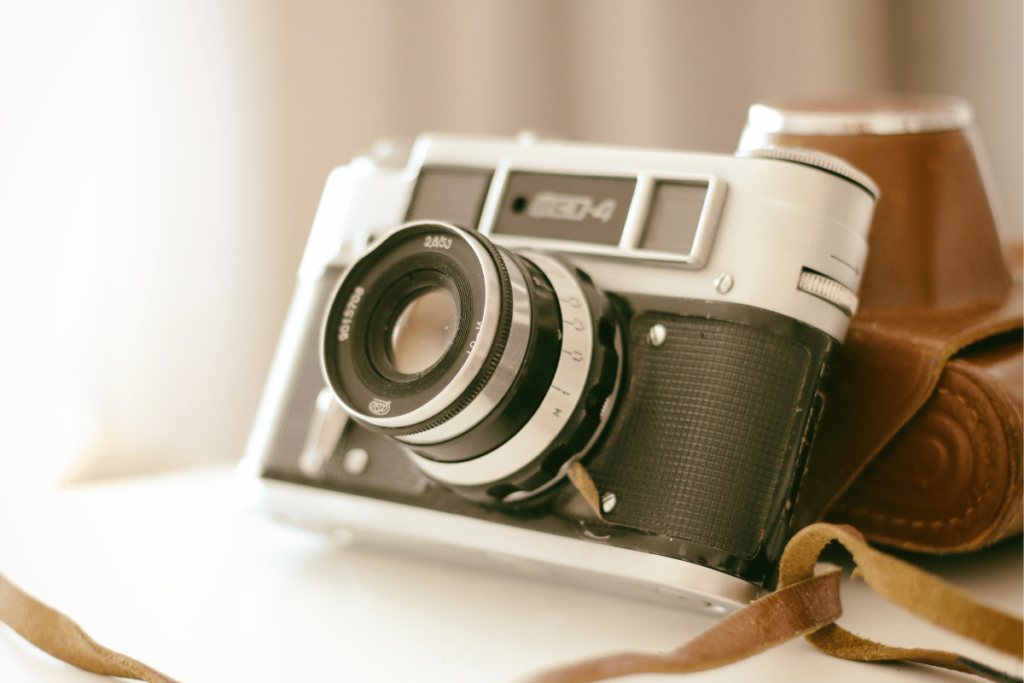
Have you ever stumbled across a beautifully nostalgic photo and wondered what magic lies behind its creation? Often, the secret is simpler than you think: a point and shoot film camera.
These cameras are beloved for their simplicity, portability, and the unique charm of the photos they produce. But what exactly is a point and shoot film camera, and why do some photographers still swear by them in a digital age?
The crux of this article is to dive into the world of point and shoot film cameras.
We’ll explore how they work, discuss their advantages and disadvantages, and guide you in choosing the right camera for your needs
How Does a Point and Shoot Film Camera Work?
Ever wondered, what is a point and shoot film camera and how it magically turns moments into tangible memories? Well, let’s dive into the workings of this simple yet fascinating gadget.
Loading the Magic Roll
First things first: your camera needs a roll of film. After loading it, it’s primed to capture light through its lens and shutter. Every time you press that button, you’re exposing the film to a scene, freezing it in time.
The Eye of the Camera
Your camera’s built-in light meter is the unsung hero. It gauges the light and smartly tweaks the aperture and shutter speed for you. No fiddling necessary – it’s all about that point and shoot simplicity.
Low Light, No Problem
Caught in a dimly lit cafe wanting to snap a moody shot? Your camera’s flash has got your back! It pops up and fires away in those low-light situations, so you can capture the ambiance without the blur.
From Negative to Positive
Once you’ve filled up that roll, it’s time for the reveal. Whether you opt for a darkroom adventure or hit up a lab, developing the film is where the negatives blossom into beautiful prints or further negatives, all ready for another round of awe.
Tips for Epic Shots
Now that you’re briefed on the process, here’s how you can best utilize this nostalgic wonder:
- Select Your Film Wisely: Different lighting? Different film. Aim for the right film speed to match your surroundings for a picture-perfect result.
- Steady Hands Win the Race: Keep it still, compose your shot through the viewfinder or LCD, and then it’s just a matter of a click.
- Focus to Impress: Half-press for focus, full press to capture. It’s a two-step dance to a great photo.
- Zoom Out for Quality: Tempting as it may be, leave that zoom alone. It can reduce image quality and bring in unwanted camera shake.
- Play with Perspective: Get creative! Try out various angles and distances to find your unique photographic voice.
What are the Advantages and Disadvantages of a Point and Shoot Film Camera?
When it comes to simplicity and fun, point and shoot film cameras hit the mark. If you’re not keen on diving into the nitty-gritty of aperture and shutter speed, you’ll enjoy their ease of use. There’s nothing quite like the thrill of clicking the shutter and being part of a photographic tradition. Picture yourself sauntering through the streets, the lightweight and compact design of your camera making it almost unnoticeable as it dangles from your wrist.
Travel enthusiasts, take note: these cameras are your low-maintenance companions. They stow away in your bag easily, freeing you up to immerse yourself in new cultures and experiences without lugging around heavy equipment. And let’s talk about affordability – your wallet will thank you. Compared to high-end digital cameras, these gems offer a doorway to photography without breaking the bank.
Each photo you snap has the potential to be a work of art. The distinctive look of film, with its vintage charm, is unmistakable and hard to replicate in the sterile digital realm. It’s a visual celebration of imperfections, where each grain tells a story. The unpredictable nature of film breathes life into your photos – the excitement of not knowing what you’ll get is part of the adventure.
And the Disadvantages?
Sure, point and shoot film cameras are great, but they’re not without their quirks. If you’re looking to push the boundaries of creativity with manual settings, you’ll find these cameras a bit restrictive. The automatic and fixed settings offer a hassle-free experience, but they lack the customization that seasoned photographers often crave.
In a world of high-definition and megapixels, film grain and lens distortions are noticeable. The resolution might not compare to your friend’s DSLR, but what these cameras might lack in clarity, they make up for in character.
Nobody likes hidden costs, and with film cameras, expenses nibble at your finances over time. Films need to be purchased and developed, which adds up—not to mention the environmental footprint of film waste. Each roll has limited shots too, so make each one count!
How to Choose a Good Point and Shoot Film Camera?
Consider Film Format
You’re standing in the store, eyeing a range of cameras, unsure of where to start. Look, the film format is your first clue. Simply put, 35mm is the common denominator, the friendly neighbor everyone knows. But hey, maybe you’re more of an artist at heart, then 120 film—with its larger negatives—is your buddy for stunning, detailed photos. Instant film? That’s for the spontaneous, the party-goers who need those memories in their hands, stat. Just remember, availability varies like the seasons, so pick a format that won’t leave you stranded.
Lens Quality: The Camera’s Eye
If the film is the canvas, the lens is the brush. A good lens brings out the sharpness, the contrast, and the splash of colors in your photos. And those special features aren’t just marketing fluff—they’re your tools for becoming a photo maestro. Wide-angle? Capture that cityscape. Macro? Get close, like, bugs-in-your-face close. Zoom? How about intimate shots from a not-so-creepy distance. Choose wisely, as the lens defines your artistic flair.
Battery Life: Don’t Get Caught Dead
Ever been on the perfect evening out, only to find your camera as responsive as a brick? The battery is often the unsung hero, giving life to your camera and flash when you need it most. Rechargeable is convenient and eco-friendly, replaceable gives you longevity, and disposable—you guessed it—easy but a bit wasteful. Think long-term and how often you’ll use it; this isn’t just a camera, it’s your memory catcher.
Extra Features: The Cherry on Top
Autofocus makes life a breeze, especially for the snap-and-go photographers. But there’s more—a self-timer for when you want to sneak into the frame, multiple exposure for your experimental side, even a date stamp for the sentimental. Panorama? That’s right, stretch those horizons. These features aren’t mere gimmicks; they’re what elevate your photography game from good to ‘Is this even my shot?’ levels.
Aesthetics: Looks Matter, Too
It’s shallow to say, but we all judge books by their covers, and cameras—by their looks. That sleek, retro Olympus Stylus Epic might match your vintage leather jacket just right.
What are Some Examples of Famous Point and Shoot Film Cameras and Photographers?
The Epitome of Luxury: The Leica M6
If you’re diving into the world of point and shoot film cameras, you can’t help but hear about the Leica M6. It’s like the Rolls-Royce of cameras, combining luxury with precision. Known for its exceptional build and image quality, the M6 has been the trusted companion of legendary photographers such as Henri Cartier-Bresson, Robert Capa, and Annie Leibovitz. They’ve captured some of the most iconic images of the 20th century with this 35mm marvel, making it a hallmark of the photography world. Its manual controls give you that hands-on experience while retaining the simplicity you love about point and shoots.
Instant Charm with the Polaroid SX-70
Polaroid changed the game with the introduction of the SX-70. This sophisticated instant camera became an instant classic, pun intended. Artists like Andy Warhol, Helmut Newton, and David Hockney found creativity at their fingertips with the ability to produce photos on the spot. With its stylish design and foldable body, the SX-70 wasn’t just a camera—it was a statement piece. The instant gratification of peeling apart a fresh Polaroid photo just never gets old, does it?
The Disposable Culture Icon: The Kodak Disposable Camera
Now let’s talk simplicity at its best—the Kodak Disposable Camera. This little guy played a huge role in democratizing photography, opening the doors for everyone to capture moments without worrying about the costs of a pricey camera. It resonated with indie kids and the youth culture throughout the 90s and 2000s, turning it into a cult favorite. Can you imagine how many memories were captured at concerts and road trips with these? It’s the embodiment of the “shoot now, think later” philosophy.
Frequently Asked Questions
What is the main appeal of point and shoot film cameras?
Point and shoot film cameras are prized for their simplicity, convenience, and the unique, nostalgic quality of the images they produce. Their affordability also makes them accessible to a wider audience.
Why are film cameras experiencing a resurgence?
Film cameras are experiencing a resurgence due to their analog quality that provides a sense of authenticity and hands-on creativity that digital cameras often lack.
How do point and shoot film cameras work?
Point and shoot film cameras operate by loading film into the camera, utilizing a built-in light meter to gauge exposure, and using a flash for low-light situations. They are designed for ease of use and simplicity.
What are some tips for taking great photos with a film camera?
Some tips for great film photography include choosing the right type of film, ensuring the camera is steady when taking a shot, and experimenting with different perspectives to add interest to your photos.
Which famous point and shoot film cameras are mentioned in the article?
The article mentions the Leica M6 for its exceptional build and image quality, the iconic Polaroid SX-70 for its instant photo feature, and the Kodak Disposable Camera for its role in making photography more accessible.

